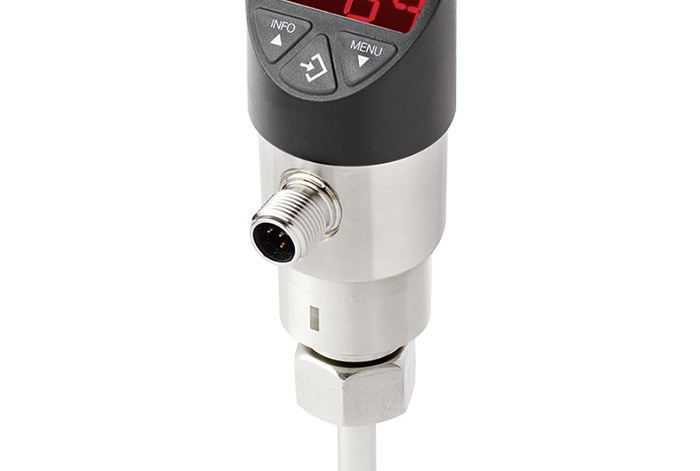
With no moving parts, better precision, and digital or analog output, calorimetric flow switches are better suited than mechanical flow switches for applications with contaminated or aggressive media. A calorimetric flow switch, also known as a thermal flow monitor, is made up of two temperature sensors. One sensor measures the temperature of the medium flowing through the pipeline; the other sensor is heated with a wire. There are two possible configurations:
- One configuration uses constant power to heat the sensor.
- Another configuration maintains a constant temperature difference between the two sensors using a variable power for the heated sensor.
How a Calorimetric Flow Switch Works
The flowing medium has a cooling effect on the heated sensor as the molecules of the medium flowing in the pipeline collect heat from the heated sensor and carry the heat away. In the constant power — or continuous heating — configuration, the higher the flow in the pipeline, the bigger the temperature drop in the heated sensor, and the smaller the difference in temperature between the two sensors. Therefore, the variations in temperature difference between sensors are an indication of the flow in the pipeline. In the constant temperature difference — or regulated heating — configuration, the flow cooling the heated sensor requires providing more heating power to the heated sensor to keep the temperature difference constant between sensing elements. Thus, the extra power needed to heat the heated sensor is a measure of the flow in the pipeline. Based on this information, the system sends an output signal to a controller and triggers the switch.
Advantages of Using a Calorimetric Flow Switch
Calorimetric flow switches are a great solution for controlling and monitoring of cooling circuits and lubricants, and preventing the effects of blockage in filters. They also act as dry run protection in pumps. Here are some of the features that make calorimetric flow switches such a good fit for so many applications:
- Having no moving parts. This makes them free of wear and are an ideal option for contaminated media instead of mechanical flow switches, which can malfunction when working in this kind of media.
- Ability to work well with electrically nonconductive media, such as oil and grease.
- Resistance to aggressive and corrosive media because they are made of stainless steel, Hallestoy®, Monel, titanium, and other metals.
- Tolerance for variations in media temperature, density, and conductivity.
- Virtually maintenance-free. Only when the medium is particularly sticky is periodic cleaning of sensors required.
- Minimal power required to function. Calorimetric switches work consistently on batteries for long periods of time.
- Digital or analog output.
- Better precision, with some featuring a <2% error rate.
- Optional built-in sensor measures the temperature of the medium, creating a 2-in-1 measuring instrument.
- Diagnostic functions in some models warn when a sensor defect occurs.
- Increasingly more cost-effective because of new technological developments.
Calorimetric flow switches are replacing mechanical and magnetic flow switches and may be the best choice for your application. They provide reliable flow monitoring even in harsh conditions, saving downtime, money, and headaches. Learn more about calorimetric flow switches and how WIKA’s versatile calorimetric flow switch with temperature and diagnostics can improve your processes.

